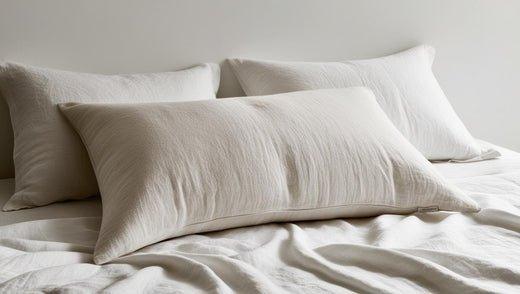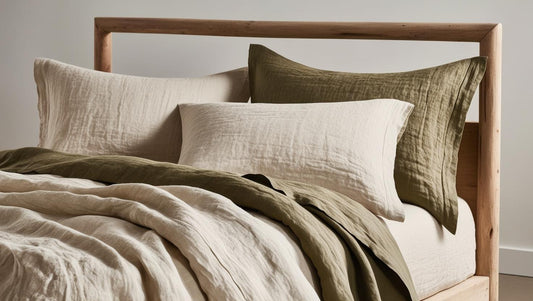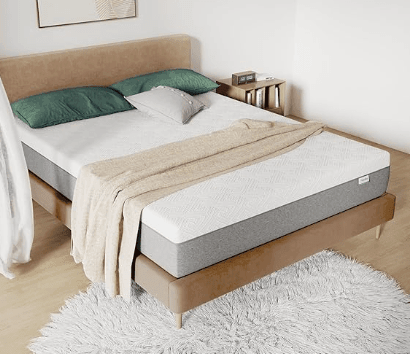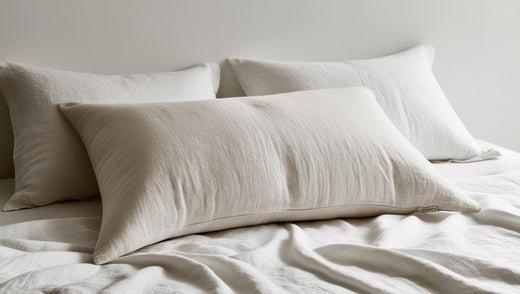
Best Pillows for Every Sleeper: Your Ultimate Guide
Share
Let's dive into a detailed review of different pillow types, focusing on firmness, support, and shape:
I. Fill Materials and Their Characteristics:
By understanding the different types of pillows and their characteristics, you can make an informed decision and choose the perfect pillow for a comfortable and restful night's sleep.
|
Sleeping Position |
Ideal Firmness | Recommended Material/Pillow Types | Key Benefits |
| Stomach | Soft | Down | Luxurious Comfort |
| Back | Medium | Feather, Memory Foam, Medium Firm Latex | Balanced Support and Comfort, Pressure Relief |
| Side | Firm | Buckwheat Hulls, High density memory foam, firm latex, contour pillows | Excellent Neck and Spine Support |
Before discussing specific pillow types, it's crucial to understand the materials they're made of, as this significantly impacts firmness, support, and longevity:
- Down: Made from the soft undercoating of ducks or geese. Known for its exceptional softness, lightness, and breathability. Down pillows are generally expensive and require proper care. They offer minimal support and are best for stomach sleepers or those who prefer a very soft pillow.
- Feather: Typically a mix of down and feathers, with a higher proportion of feathers. More affordable than pure down but less soft and supportive. Feathers can poke through the fabric.
- Memory Foam: Viscoelastic polyurethane foam that contours to the shape of your head and neck. Offers excellent support and pressure relief. Can retain heat and may have an initial chemical odor. Available in various densities (firmness).
- Latex: Made from natural or synthetic rubber. Offers good support, responsiveness, and breathability. Naturally hypoallergenic and resistant to dust mites. Can be more expensive than other options.
- Polyester Fiberfill: Synthetic fibers that mimic down. Affordable and hypoallergenic but tend to flatten over time and offer less support than other materials.
- Buckwheat Hulls: The outer shells of buckwheat kernels. Provide firm, contouring support and excellent airflow. Can be noisy and heavy.
II. Pillow Types Based on Firmness and Support:
-
Soft Pillows:
- Down Pillows: The epitome of softness. Ideal for stomach sleepers who need minimal loft (height) to avoid neck strain. Not recommended for back or side sleepers.
- Some Polyester Fiberfill Pillows: Lower-quality fiberfill pillows can be very soft but offer little support and flatten quickly.
-
Medium Firm Pillows:
- Feather Pillows (with a higher down content): Offer a balance of softness and support. Suitable for back sleepers who need moderate loft.
- Some Memory Foam Pillows: Medium-density memory foam provides good contouring and support without being overly firm. Suitable for back and some side sleepers.
- Latex Pillows (medium firmness): Offer a responsive and supportive feel. Suitable for back and side sleepers.
-
Firm Pillows:
- Buckwheat Hulls Pillows: Provide very firm, contouring support. Ideal for side sleepers who need significant neck support.
- Some Memory Foam Pillows (high density): Offer maximum support and minimal give. Suitable for side sleepers and those who prefer a very firm feel.
- Latex Pillows (firm): Offer a firm, resilient feel. Suitable for side sleepers.
III. Pillow Types Based on Shape and Intended Use:
- Standard Pillows: The most common size (approximately 20x26 inches). Suitable for most sleepers.
- Queen Pillows: Slightly longer than standard pillows (approximately 20x30 inches). Suitable for larger beds or those who prefer more sleeping surface.
- King Pillows: The largest standard size (approximately 20x36 inches). Suitable for king-size beds.
- Neck Support Pillows (Cervical Pillows): Designed with a contoured shape to support the natural curve of the neck. Often made of memory foam or latex. Ideal for those with neck pain or stiffness. Can be beneficial for back and side sleepers.
- Body Pillows: Long, narrow pillows designed to support the entire body. Popular among pregnant women and side sleepers. Can help with spinal alignment and pressure relief.
- Wedge Pillows: Triangular pillows designed to elevate the upper body. Can help with acid reflux, snoring, and sleep apnea.
-
Contour Pillows: Feature curves and indentations to cradle the head and neck. Often made of memory foam or latex. Suitable for back and side sleepers.
- Benefits: Cradles the head and neck, providing customized support and promoting proper spinal alignment. Can be beneficial for both back and side sleepers.
- Best for: Back and side sleepers seeking enhanced comfort and support.
IV. Choosing the Right Pillow:
Consider the following factors:
- Sleeping Position: Side sleepers need a thicker, firmer pillow to support the neck and keep the spine aligned. Back sleepers need a medium-loft pillow that supports the natural curve of the neck. Stomach sleepers need a thin, soft pillow to avoid neck strain.
- Body Size: Larger individuals may need a thicker pillow.
- Personal Preference: Firmness and feel are subjective.
- Budget: Pillows range in price from affordable polyester fiberfill to expensive down.
- Allergies: Consider hypoallergenic materials like latex or polyester fiberfill.
| Type | PRICE | Feature |
| California Design | 46.99 | 100% Cotton Sateen |
| Cosy House | 54.95 | Bamboo Memory Foam |



